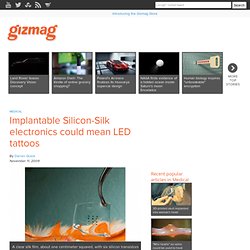

Implantable Electronics Dissolvable devices make better medical implants.

Implanted under the skin, an array of light-emitting diodes could signal the concentration in the blood of biomarkers such as insulin. Over time, the array will dissolve away, eliminating the need for surgery to remove the implant. Flexible silicon electronics (inset) are held in place with a silk film. Incorporating antibodies or enzymes into the film will allow devices to detect biomarkers. Bryan Christie Design Fiorenzo Omenetto (Tufts) Biodegradable electronics could make implantable devices easier on the body OTHERS WORKING ON IMPLANTABLE ELECTRONICS John Rogers, University of Illinois Urbana-Champaign, IL Zhenan Bao, Stanford University, Stanford, CA This article is part of an annual list of what we believe are the 10 most important emerging technologies.
The next generation of implantable medical devices will rely on a high-tech material forged not in the foundry but in the belly of a worm. Silkapl.pdf (application/pdf Object) LED Tattoos. Electronic Ink: LED Tattoos Implanted by Silk. Sources: Wired, H+, MIT Technology Review A demonstration from Philips Electronics showing the possibilities of implanted LED “tattoos.”

Pretty kinky, but there are already practical applications being considered. The Illustrated Man. Tattoos have mostly been static graphics, limited in their usefulness in communication certain info. But researchers from the University of Pennsylvania have now come up with LED tattoos that can turn your skin into a living screen. I initially reported on the silk implantation in the forums, while Kenryouku_One gets props for the follow up on how the tech is being used to implant the LEDs.
A silky entry. By building thin, flexible silicon electronics on silk substrates, researchers have made electronics that almost completely dissolve inside the body. Silk has been used before and is approved by the US Food and Drug Administration for medical use. Tramp stamp one second, instructions the next. It’s written all over your face… and the back of your wrist. Implantable Silicon-Silk electronics could mean LED tattoos. A clear silk film, about one centimeter squared, with six silicon transistors on its surface about to be implanted into a mouse (Photo: Rogers/Omenetto) Tattooing dates back to at least Neolithic times and has experienced a resurgence in popularity in many parts of the world in recent years.

Advancements in tattoo pigments and the refinement of tattooing equipment has seen an improvement in the quality of tattoos being produced. Today it’s possible to get ink that glows under UV light, but a new technology could see tattoos that emit their own light. Implanted LED Tattoos May Become The Next Big Trend. While it may seem like tattoos are the norm now, no one has ink like this.

A team from the University of Illinois led by John Rogers has devised a method to actually install LED lights under the skin. The research, published today in Nature Materials, saw the team develop flexible arrays 2.5 μm thick and 100 x 100 μm square which are currently smaller than any commercially available array. LED tattoo. A light-emitting diode tattoo is a type of body modification similar to a tattoo, but specifically involves implantation of technologically based materials verses traditional ink injection into the layers of the skin.

LED tattoos are accomplished by a combination of silicon-silk technology and a miniature lighting device known as a light-emitting diode. While there is potential for many applications in the medical, commercial and personal domains, the technology is still in the development stage. Once the ability is attained to condense the parts of a LED to a small enough level, it will be possible for the tattoos to be implanted in humans.
Technological limitations[edit] Current medical devices are limited by their isolation from the body and their placement on rigid silicon.[1] Current devices also contain gold and titanium which are required for electrical connections. Development[edit] Medical application[edit] References[edit] External links[edit] Crea tu propio panel solar y ahorra hasta un 70% en la cuenta de luz.